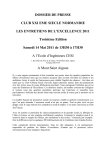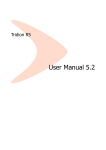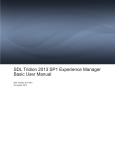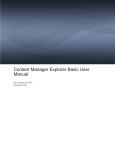Download SDL Tridion 2013 user manual
Transcript
SDL TRIDION 2013 USER MANUAL This training allows maintaining the existing pages and creating new ones using SDL Tridion. You will learn how to Log into SDL Tridion, make text changes, make new pages, make a link, add images, insert or edit a table, upload documents, and send work for approval. Inline Editing: Edit existing page and create a new page. Table of Contents Browsers ....................................................................................................................................................... 2 Log-in............................................................................................................................................................. 2 Editing existing page ..................................................................................................................................... 2 Fonts.......................................................................................................................................................... 4 Heading ..................................................................................................................................................... 4 Email Link .................................................................................................................................................. 5 Add an Image ............................................................................................................................................ 6 Upload an Image ..................................................................................................................................... 11 Link to pdf, Word doc, Excel, PowerPoint............................................................................................... 15 Upload a pdf, Upload a pdf, a Word document, Excel, or PowerPoint presentation............................. 18 External Link ............................................................................................................................................ 20 Internal link ............................................................................................................................................. 20 How to locate a component used by an internal page ........................................................................... 24 Adding a Table......................................................................................................................................... 25 Edit an Existing Table .............................................................................................................................. 26 To finish editing the page at a later time ................................................................................................ 26 How to preview the changes before submitting to workflow .................................................................... 28 Submit to the Workflow ............................................................................................................................. 30 Create a New page ...................................................................................................................................... 32 Changing the page and the Component locations...................................................................................... 33 Component in new page ......................................................................................................................... 37 Adding a New Component ...................................................................................................................... 38 1 Browsers Tridion SiteEdit is compatible with all the browsers, however it is recommended to use Firefox. Pop-ups blocker should be set to allow tcm pages to open. Log-in Navigate to the page to edit, and delete www and replace it with https://stage and click enter. You may want to bookmark this page for future editing. Click the SDL Tridion button In the logging window enter UML email address and password. Once the logging is successful, the ribbon toolbar appears, set to the Home tab. Editing existing page Click on the content to see the border, and borders appear around editable pieces. If the ribbon toolbar can be seen, but not the contents of the Web page, the browser may be preventing the content from being displayed because it does not consider the content secure. If this happens, do the following: • In Google Chrome, click the shield icon at the right hand side of your address bar and select Load anyway. • In Mozilla Firefox, click the shield icon on the left hand side of the browser address bar and select Disable Protection on This Page. • In Internet Explorer, a message appears on the bottom of the Web page: "Only secure content is displayed." Select Show all content next to the message. Tridion Experience Manager draws borders around editable areas in the web page (see image below) 2 Web page (1) If the Web page as a whole is editable, Experience Manager draws a border around it. By default, you only see it when hovering over the edge of the page, but you can make it always visible. Component (2) If a Component on the Web page is editable, Experience Manager draws a border around it. By default, you only see the border when hovering over the Component, but you can make it always visible. Field (3) If a field of a Component is editable, Experience Manager draws a border around it, but only if you select the Component first and then hover over the field. This also goes for fields within fields (4). Borders and colors The color of an item border tells you something about the status of that item. By default, an item can have a border in one of the following colors: Blue A blue border indicates that you can edit the item. Green A green border means that there are pending changes to this item for you to commit or discard. Red A red border means that your changes cannot be saved, because the content you entered is invalid or incomplete. Grey A grey border means that you cannot (currently) edit this item. These colors are defaults. Your application administrator may have changed them. The color of borders around the fields of a Component are as follows: • If the Component has a blue or green border (or its configured alternative), so do all of its fields. • If the Component has a grey border (or its configured alternative), its fields have no borders. • If the Component has a red border (or its configured alternative), the field or fields that are invalid also have a red border. 3 Auto save is enabled, there is no need to save changes that is why the Save Draft function is grayed out Fonts For design purposes, the font style and the color are not to be changed. If the content is prepared in a Word document, copy and paste to Notepad or other text editor first then copy from Notepad to your page. To format the content you can use Text Field Properties or the formatting toolbar. Text Field Properties Formatting Tool bar The first title in the component is always heading 2 by default. The green title formatting will be discussed in the creation of a new page. Heading Only heading 2 and heading 3 are used in editing content in Tridion. To apply a header to a content box, highlight the words you want in the headline and select heading 2 or heading 3 from Section Type in the formatting tool bar. Or just place the cursor in the line that needs the header change and select an option (2 or 3 only) from the dropdown menu. 4 Example of heading 2 Example of heading 3 Title 3 to be heading 3 Email Link To link to an email address, highlight the content you wish to link (it is preferable to type the whole email address), in the ribbon tool bar select Insert tab Then click Hyperlink. 5 Now under Type field select mailto, in the URL field after mailto:(no space) type the appropriate email address, and in the Title field add a description of the email (or the person’s name), then click OK. Add an Image Click at the beginning of the paragraph when you want to insert the image. Select the Insert tab in the formatting toolbar Then click Image button 6 After the Image pop up window is displayed A window slide on the left will display the folder Building Blocks, click on the arrow. Then click Content. 7 Navigate to the desired folder within your department folders. Go to Multimedia folder. Click Images folder. Select the image you want to insert. And click Select on the top of the slide window. 8 Click Advanced to format the image. • In the Text field type a good description of the image 9 • In the Alignment field select the desired location (mostly float left or float right) • • • The maximum Width should not exceed 200 The maximum Height should not exceed 200 Keep the Proportion field checked 10 Then click OK. Upload an Image To upload an image to be added to the page, follow the same procedure to add an image until the step where Image folder is opened. Click at the beginning of the paragraph when you want to insert the image. Select the Insert tab in the formatting toolbar. 11 Then click Image button. After the Image pop up window is displayed. A window slide on the left will display the root folder Building Blocks, click on the arrow. 12 Then click Content. Navigate to the desired folder in your department. Go to Multimedia folder. Click Images folder. At the bottom you will find the area where you have an option to drag and drop or upload the image. Drag and drop is straight forward. 13 Click to upload will prompt a new window, which will allow you access to your computer or shared drive or USB drive Find the image you want to use, select then click Open. The Metadata window is open to edit the image’s alt text. 14 Make it a good description, then click Save and Close After this step click cancel, click outside the component, then click back inside it. Follow the instructions in “Add an image “paragraph. Link to pdf, Word doc, Excel, PowerPoint Type the name of the text file you want to add to your page, and add the extension in parentheses in the format below: File name (file extension). For example: Test 1(pdf), or test 2 (doc) … highlight the name of the file but not the parenthesis. In the ribbon toolbar select Insert tab. Then click Hyperlink. 15 In the following popup window select Component for Type and New Window for Target. Click browse button. A window slide on the left will display the Building Blocks folder, click on the arrow. Then click Content and navigate to the desired folder. 16 Inside the desired folder click to navigate to docs folder where all the pdf, word documents and excel files are stored. Click on this folder, and locate the file you want to use. Then click Apply. In the Hyperlink window, click OK. 17 Upload a pdf, Upload a pdf, a Word document, Excel, or PowerPoint presentation Highlight the content to be linked to the file. In the ribbon toolbar select Insert, then Hyperlink. Select Component, and set the Target to New window. In the slide window navigate to the right folder. 18 Then navigate to docs folder within your department. Click on the folder. Then drag and drop the file in the bottom field. And click Apply. Then click OK in the Hyperlink window. 19 External Link Any link outside of Tridion is considered external link. A typical Tridion page is in the format: www.uml.edu/dept/.../PageName.aspx Highlight the content to be linked, and in the ribbon toolbar select Insert tab, then Hyperlink. In the following popup window select HTTP:// for Type. And New Window for Target. Type or copy and paste the address in the URL field. In case if you paste it make sure the new address does not duplicate “http://”. Check if the link is working by clicking folder/arrow icon. Internal link Any link within Tridion (www.uml.edu/dept/.../PageName.aspx) is considered an internal link and linking to a Tridion page is done by linking to the component used by that page. Whereas The URL of the page you are trying to link to can change and the only way to avoid a broken link is to navigate and link to the component used by that page. 20 First highlight the content to link then select the Insert tab in the ribbon tool bar Then click Hyperlink. In the next window select “Component” under Type, and Default for Target. Then click the browse button. . A slide window will appear in the left. 21 Click on arrow next to Building Blocks. Then click Content. Navigate to the desired folder. Once in the right folder look for the component. 22 Select the component you want to use, and then click Apply on the top of the slide. The title field should provide a description as to where the link takes you. Once done, click OK. 23 Note When linking to landing pages, select a component named “link this for the dept. landing page.” How to locate a component used by an internal page Open the page to link to, then change www in the URL with https://stage and log-in to Tridion. Click inside the component. In the ribbon toolbar under Home tab click in Open in Form View. Click the Info tab. In the example below: the component name is “test-Amy” and the location is the main “Admissions” folder Will be the component and the name will be displayed at the right And will show the component’s location in the Content Manager (back-end). Then you follow the procedure under Internal Link section. 24 Adding a Table Place your cursor at the location where you want to insert the table. In the ribbon toolbar click Insert tab, then Table button. When Insert Table window appears, enter the numbers of rows and columns. Click OK when done. A table editor window will pop up. By default the content will be Body style (normal formatting). To make table heading: select Row tab, click inside the row, and in the Row Formatting menu in the Body/Header/Footer section select Header. Then click OK. 25 In SiteEdit mode click inside the cell and type the table content. Edit an Existing Table To edit an existing table click inside the table, In the formatting toolbar select Format then under Current Elements drop down menu select *Table<table>, then click Table button under Insert tab. In the Table Editor window click inside any cell to activate the top menu which will allow you to remove/insert row above or below, remove/insert column to the left or to the right … Apply the changes, and click OK. To finish editing the page at a later time Click the link icon in the top right of the editable border. 26 Copy and save your URL somewhere where you can easily find it. Then click the in the top right of the Tridion page not the browser. Click Continue editing later. When ready to edit the page just paste the saved URL, and log-in to Tridion. When prompted with the message. On the page’s top right click to update. Or Click Update Preview in the ribbon toolbar 27 How to preview the changes before submitting to workflow After editing the page, click outside the component being edited. Under Home tab in the ribbon toolbar, click Finish Editing. To preview the page before submitting, click Things to do tab in the top left Select the component to preview Click Finish Activity 28 And in the Next activity drop down menu select Publish for Preview Then click Done 29 Now copy the stage page url by click Paste it in a new browser tab to check the links and the page layout. Now go back to “Things to do” and click “Assigned”. Select the component you are working on and Click Start Activity if more edits are required, and click inside the component. Otherwise follow the next steps. Submit to the Workflow Click Finish Activity 30 Finish Activity Message: In the comment box type the summary of all the edits and a message to the webcontent team if needed. Remember when you submit to the workflow, by default the page will be published live. If you want the page to go stage only, you need to mention it in the comment box and type”publish stage only”. Also if you need to add a page to navigation (left hand menu in the live website) mention it in the comment box and specify the exact location in navigation. 31 In the Next Activity menu select Submit to workflow, and click Done Then click Done. Create a New page Under the ribbon toolbar, select Home tab then click New Page. Select a specific page in your department from the slide window to the left. For Admissions website use either: • • • • Admissions News page Admissions Page with Picture and sidebar (level 2) Admissions page with Picture (level 3) Admissions Page without Picture For other departments “Admissions” will be replaced by your department name automatically. 32 Click Create. In the pop-up window fill in the Page Title, and the File Name. In the File Name use a dash and avoid spaces. Changing the page and the Component locations You can change the page location if needed (if you have more than one folder in your department) by clicking Change next to Page location field. And in the window slide navigate to the right folder (pink color) then click Change. 33 If you need to change the location of the component click click browse . Then . Navigate to the desired folder (yellow color), and select. 34 Click Apply. Click Create Page. 35 The page will reload with a blank page. To change the green title select Open in Form View under Home tab in the ribbon toolbar. The page will be open in the back-end of Tridion rather than Experience manager (SiteEdit). You can edit the display title and add a navigation title if needed. 36 In this step the page template can be changed from level 4 to level 2 or level 3 or vice versa. In the page template drop down menu select level 2 or level 3 Then add a feature image (Feature image is required for level 2 and level 3 pages). Note: Feature image must be optimized by the Webcontent team to fit the customized area in the page. Please email all images to be optimized to [email protected]. In the feature image box click browse And in the new pop-up window navigate to the folder containing the feature image: Department/multimedia/Feature image folder Select the image and click Insert, then click Save and Close on the page’s top left. Component in new page When a new page is created using department template, the component will be created automatically once the page is reloaded. You can use the steps in the editing an existing page to edit this component and submit to the work flow. 37 Adding a New Component In the ribbon toolbar, click Home tab then under Insert Content select Create and Insert new Content. In the slide window click Main Content then click Choose. In the pop-up window fill the Content Title and make it the same name as the page. Change the location by unchecking the Use Default Folder and click browse, navigate to the folder corresponding the page’s folder (same name just the color is yellow). Then click Create and Insert Content. 38 Note: Name the component the same name as the page After the page is refreshed (automatically) the component is added to the page, and it displays a heading and content allowing edits. To start editing just click inside the content, and follow the directions from the beginning of this manual. To submit to the workflow Under Home tab in the ribbon toolbar, click Finish Editing. CMS Training Cumnock C-7, One University Avenue, Lowell, MA 01854 Phone: 978-934-1873 Fax: 978-934-3033 Contact Us 01/07/2015 by Hichame Asrary 39


















































